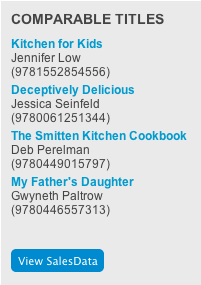Comp titles in CataList
Need a comp title? CataList has you covered!Last week on the blog, 2012 PubFight champ Bill Holt weighed in on his scientific approach to the PubFight auction. But publishers and retailers alike know there is more to acquisitions and frontlist buying than science alone. While science certainly plays an important role, a lot of seasoned editors and buyers have good instincts about how a new book will sell based on experience—the art of buying rather than the science, if you will. But if you’re new to the industry, how do you learn this art?
The best tool in your arsenal is the “comp” title. Short for comparison or comparable title, the comp title is an existing book that a buyer can use as a baseline to estimate the projected sales track for a new book. Finding the right comp and leveraging information in SalesData can help you decide how much you should bid in the auction, and how many copies of the book you should print. After the book comes out, a good comp provides a baseline for monitoring performance, managing risk and projecting reprint needs.
Finding comp titles is a bit of work if you want to do it right, but it’s well worth the effort. Let’s look at two examples from my PubFight list this year: Lee Child’s Never Go Back and Mary Swan’s new novel My Ghosts.
The Next Title in a Bestselling Series
The new Lee Child book is a pretty straightforward case. This is an established author with lots of sales history. In this case, the previous title or two by the same author are probably good comps. Looking at the detail page for this title in CataList, you can see that the publisher has already suggested a number of possible comp titles from the author’s backlist (Note: you need to be signed into CataList to see the comp title suggestions). Still, a bit of research will serve you well—Never Go Back is the new Jack Reacher novel, so make sure you are looking at the sales performance of recent titles from the same series for your comparison.
Next, you can consider some other factors that may impact sales. Do you think last year’s Jack Reacher movie will have gained the series more fans? Will those fans buy a hardcover copy of this title, or will they buy the ebook? Maybe you want to increase your first print run a bit in case more people purchase the book in hardcover as soon as it comes out? And don’t forget to adjust for the release date—if the book is coming out later in the PubFight period, you’ll want to take that into account.
My strategy for this one will be to print about the same as the amount sold last year for the Christmas period up front. That way, if more people do purchase as soon as the book releases I won’t be out of stock, but I’m still pretty confident I’ll sell through everything I printed if not.
Literary Fiction with Awards Potential
My Ghosts, the second novel by Guelph author Mary Swan, is a bit harder to predict. The publisher doesn’t suggest any specific comps for this one, so I’m on my own to figure out how this book might perform. Swan’s first novel, The Boys in the Trees, was shortlisted for the Giller Prize in 2008, and her short story The Deep won the O. Henry Award in 2001. This is an author who takes time to craft her work, and she’s one of the calculated risks on my list—I’m hopeful that I’ve picked up an author with Giller nod potential for cheap in the auction!
Figuring out my initial print run is a little more complicated with this title. I’m going to look at multiple comps, and work within the range set by these titles. I use this technique when estimating potential for debuts as well, using titles that I think will appeal to a similar market.
One comp will of course be the author’s previous novel, The Boys in the Trees. Random House is reissuing that title in Canada this fall, which tells me something about their expectations for breaking out this author. That title’s history will be my baseline, but I need to take into account that it was a trade paperback release in Canada. For my other comps for this title, I paid specific attention to previous award winners I felt might have a similar track, such as Alexander MacLeod’s Light Lifting.
I also need to also look ahead at what the sales potential might be for this author if she figures into any literary award lists. To make sure I don’t get caught short, I’ve reviewed BookNet’s most recent Literary Awards in Canada research study to see what the potential might be (Note: BNC research login information is available to SalesData subscribers through the SalesData home page). I don’t want to print initially at Giller levels of course, but since I may get caught short if the title takes off, I’ll need monitor the sales track and the awards scene weekly so I’m prepared to reprint quickly.
After all that factoring, I’m planning to initially print about 20% more than the previous book sold to minimize the potential for lost sales, and keep one hand hovering over that reprint button. It’s a bit of a risk, but with the competition in this office—and in the real world—it’s hard to win without taking a few risks! Doing your comp title research and keeping up to date on trends compared to your baselines can help you manage those risks and propel you to the top of your PubFight league.
Good luck!



